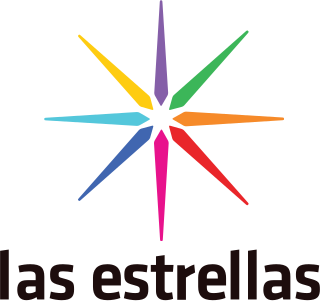History
Early years
In 1981, Nicolas Gonzalez Revilla founded Telemetro as a metropolitan VHF scrambled pay-per-view channel. The first broadcast was held on October 13, starting at 4pm and ending at 10pm. The initial style of the channel was based exclusively on movies from the Golden Age of Hollywood, which was an obligation given the market conditions and the competition for content at the time of its creation. [1] : 28
The initial plan was to make Telemetro a cable channel. However the original plan was scrapped as soon as it was discovered that the content providers rejected if the service was to be launched on cable. Facing this situation, and the lack of other places to obtain content, as well as the commercial strategies of the existing private television stations in Panama, caused the project to convert to over-the-air terrestrial. Buying content to fill the schedule was difficult in an initial stage, however the ambitions of the negotiating team led by Analida López caused a shift in the strategies. [1] : 28
The station's initial team consisted of thirteen people, at a challenging period where commercial television was dominated by two companies (RPC and Tevedos/TVN), without giving room for new television channels. The situation was broken on October 22, 1980, when the government revised its laws on television stations. [1] : 29
The station was the first in Panama to use computer graphics, as well as the first to make full-on program promotions, unlike its competitors, who at the time relied exclusively on static slides and live announcements. Despite its initial obstacles, Telemetro allowed the broadcast of three daily movies from the past. [1] : 30 The station employed the U-matic videotape system, while the portable cameras used were divided in two parts, camera and recorder. All this equipment occupied the small facilities and had a large storage; to circumvent this problem, it was suggested that larger facilities would be needed to accommodate such equipment. [1] : 56 The way the channel did commercial advertising was equally disruptive, with ten minutes per hour to insert commercials, where "cheap style" commercials wouldn't be allowed because this would go against the channel's image of a cable - though terrestrial - network. The format wasn't successful and was later replaced by a free-to-air service. [1] : 31
Influenced by the then-recent launch of MTV, the channel's first locally-made program was created: Los Grandes de la Música, a music video program aimed at the youth. The channel also started expanding its signal, which also meant searching for new audiences, starting in the Atlantic zone of the country, specifically in Colón. [1] : 31
The station started broadcasting to Colón in 1983 on channel 7 with a special edition of Los Grandes de la Música. Its identifications started displaying the frequencies for both Panama and Colón (13 and 7) and added the slogan "de costa a costa". The new slogan implied its ambition to grow to ultimately become a national channel. [1] : 32
The news operation launched in 1982 during the commercial breaks under the name Boletín del 13. The following year, a full hour-long newscast started, competing against RPC and TVN's counterparts, with its own unique style. It was later renamed Telemetro Reporta. [1] : 33
In December 1989, a special four-day edition of Telemetro Reporta was broadcast, showing all the footage that was withheld from broadcast during the dictatorship, which had just ended. [1] : 36
Growth
The station's initial facilities showed clear limitations in the creation of new national productions. Negotiations with Martinez Blanco, one of the pioneer entertaining figures of Panamanian television, led to the creation of Sábados con Martinez Blanco. Following the agreement, a second studio was set up. Martinez Blanco's format ended in late 1987, after some jokes from the presenter were poorly-received by the governants. To replace the format, a new program was created, Éntrese a ganar (also styled En13 a ganar), on Sundays from January 1988. [1] : 37–38
The broadcast of Mexican telenovelas at 7pm, in the Cine Series slot (Cine Series being the name given by Telemetro to telenovelas in order to make it different from its competitors [1] : 75 ), caused competition from reruns of El Chavo del Ocho, whose rights holder in Panama had to move to 5pm in order to allow Telemetro to win the slot. By the end of the decade, Telemetro had produced a large amount of national productions, including daily formats, which was unusual at the time. [1] : 39
Achieving nationwide coverage
By 1990, Telemetro had started broadcasting live Carnaval events, as well as a new format for the January-March period: Hot Control. [1] : 45–47 Hot Control, the natural successor of Éntrese a ganar, was the first program made specifically for Panama's summer period. [1] : 88–89 The success of Hot Control cemented its relations with the viewing audience, who had increased the channel's popularity. [1] : 48 The success of the channel in the Panama and Colón areas led to videotaped copies of Telemetro programming being sent to family members outside of Telemetro's coverage area. The arrival of democracy in 1990 enabled the channel to finally expand to new provinces in Central Panama: Coclé, Herrera, Los Santos and Veraguas. [1] : 48 A special event was held in Chitré on August 31 and September 1, 1991, the city was selected due to, among others, the hotel infrastructure used for the guests. [1] : 49
In 1992, the channel had finally expanded to Chiriquí and Bocas del Toro provinces, achieving total nationwide coverage. A special event was held on the December 5-6 weekend of that year, known as El Evento-T. Up until then, areas not covered by the network only knew about its programming by means of videotapes. The station now had plans to become the leading network, and adopted a new slogan to reflect its total coverage, "El canal que llega más" (The channel that reaches more). With this, Telemetro cemented its position as a channel that connected with the Panamanian identity, and Evento-T sealed its status at reaching national level. [1] : 50 The network had also increased in the number of homegrown talents, creating the "Las caras de Telemetro" campaign. [1] : 51
The channel helped popularize new sports to Panama from 1994 onwards. Founder Nicolás González Revilla held negotiations with a FIFA official in Los Angeles to help popularize soccer, whereas that same year the channel broadcast the first broadcast of a Panamanian basketball match, without the support of the Panamanian Basketball Federation. Up until then, the dominant sports were baseball and boxing, broadcast primarily by RPC TV. [1] : 72 The negotiations between the channel's founder and FIFA also helped create the ANAPROF league, the Panamanian professional soccer league. [1] : 73
MEDCOM era
The first national work of fiction produced by Telemetro, a sitcom called Los Vergara, premiered in 1998, which aired once a week. Produced by Franco Holness, it was about a family from the inland region who moved to the capital to pursue a millionary lifestyle, without leaving behind their traits from their birthplace. By the efforts of external producer Carlos Pasquini, two new sitcoms followed in 1999: Familia Crisis and Doble Vida, with a more daring and irreverent comic style. [1] : 90
Telemetro Canal Club was created in 2002. It was a community where fans of the channel received special benefits for birthdays, taking part in Hot Control's audience, discount in participated stores, among others. The launch of the club featured the network's calendar with its female talent, its success led to 167,000 people signing up - at a time before social media - in just one day. The process was done manually. [1] : 74–75
On March 24, 2005, Telemetro Reporta broadcast for the final time from the Calle 50 studios, the first broadcast from the 12 de Octubre studios was held on March 28. [1] : 84 A regional bulletin for Chiriquí started in August 2008, which was broadcast on its sister cable news channel, ECO TV. [1] : 85
The current morning format, Tu Mañana, premiered on June 25, 2007. [1] : 94
Telemetro produces its first reality show in 2008, Señorita Bella, which followed the training period of the candidates for the Señorita Panamá pageant, where the winner would represent Panama at Miss Universe. A second season was created in 2009.
Between 2009 and 2013, Telemetro changed to a tapeless format, digitizing its archives. [1] : 57
Telemetro also entered the film industry in 2009 with the creation of TV movies financed by MEDCOM's CSR projects and with co-financing from USAID. The movie "Guetto: el destino no es igual para todos" tackled violence in impoverished areas, and became a ratings hit. A sequel premiered in 2012 (Guetto 2: El Poder de 5) which replicated its success. [1] : 92–93
On April 4, 2011, Telemetro became the first Panamanian television channel to broadcast in high definition, on Cable Onda channel 321. [1] : 59 The channel had received such equipment in the previous year. [1] : 60
In April 2012, Telemetro signed an agreement with La Estrella. [2]
El Picador became Telemetro's first production to include international actors, which began filming in 2015 and premiered the following year. [1] : 91
Telemetro was also the first channel to bring Turkish series to Panama, creating what was colloquially known as the "Turkish mania" (La Turcomanía). [1] : 97
The channel's master control system was changed in 2020 with just two strong servers, replacing the system adopted in 1998, with 20 servers, which was by then obsolete. [1] : 62











